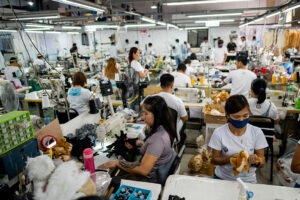PHILIPPINE FACTORIES posted their worst performance in 23 months after output fell by 0.8% in March, according to the local statistics agency.
This was a reversal of the 7.2% growth in February, based on the results of the Philippine Statistics Authority’s (PSA) Monthly Integrated Survey of Selected Industries. Factory output rose by 6% in March last year.
Robert Dan J. Roces, chief economist at Security Bank Corp., blamed rising material costs and softening domestic demand for the plunge in the output as measured by the volume of production index.
“Deterioration in operations due to this seems likely, given the substantial output drop compared with February’s revised growth,” he said via Viber.
The production decline suggests potentially weaker demand and production challenges, he added.
Month on month, the manufacturing sector’s output rose by 0.8%, compared with 0.5% in February. Stripping out seasonality factors, factory output declined by 4.7%.
Output growth slowed to 3% last quarter from 5.5% a year earlier.
This was probably due to inflation, high interest rates and the global economic uncertainty, Mr. Roces said.
Inflation quickened for the third straight month to 3.8% in April. It was 3.7% in March and 3.4% in February.
Markets expect the Philippine central bank to delay interest rate cuts because of this. The Monetary Board has kept its key rate to a 17-year high of 6.5% after increasing it by 450 basis points (bps) from May 2022 to October 2023.
Philippine Chamber of Commerce and Industry (PCCI) President George T. Barcelon attributed the March contraction to weak demand in the retail sector, the peso’s depreciation against the dollar and higher import costs.
Manufacturers could also not pass on their costs given the weak market, he said by telephone. Mr. Barcelon expects factory output growth to slow this year.
Average capacity utilization averaged 75.3% in March compared with 75.1% a month earlier and 73.6% a year ago.
In contrast to the PSA report, S&P Global Purchasing Managers’ Index (PMI) for March was 50.9, suggesting that factory activity expanded, though slower than in January.
A reading above 50 shows expansion in manufacturing activity, anything below 50 shows the opposite.
The index was 52.2 in April, the strongest improvement in five months.
The statistics agency said the factory output decline in March was driven by the manufacture of food products, which contracted by 8.1%. Food products account for 18.7% of manufacturing activity.
Also contributing to the decline was computer, electronic and optical products, whose growth slowed to 5.3%, and coke and refined petroleum products, whose growth slowed to 10.2%.
Out of the remaining 19 industry divisions, 12 posted yearly declines, while seven recorded higher growth, the PSA said.
The manufacture of chemical and chemical products had the highest growth at 29.1%. — Abigail Marie P. Yraola
